

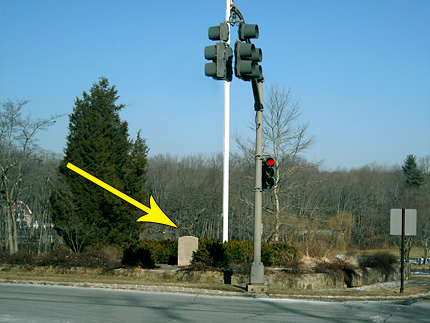
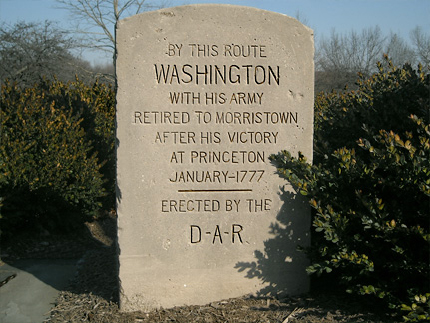
Washington Route Markers
• Intersection of Blue Mill Rd., Lees Hill Rd., Village Rd., and Glen Alpin Rd.
• Intersection of Village Rd. and Spring Valley Rd.
Map / Directions to this Marker
Map / Directions to all Harding Township Revolutionary War Sites
Following their victory at the Battle of Princeton on January 3, 1777, General George Washington and the Continental (American) Army went to Morristown for winter quarters, where they arrived on January 6. A series of thirteen markers traces the route they took.
The eleventh and twelfth markers in this series are located in Harding Township. The marker pictured above is on an island in the middle of the intersection where Blue Mill Road becomes Lees Hill Road, and Village Road turns into Glen Alpin Road. The marker pictured below is on an island in the middle of the intersection where Village Road intersects with Spring Valley Road. [1]
The other eleven markers in this series can be found in Princeton, Kingston, Griggstown, Bridgewater, Somerville, Bedminster, Bernardsville, Basking Ridge, and Morris Township. For a map tracing the route of all thirteen markers from Princeton to Morristown, click here.
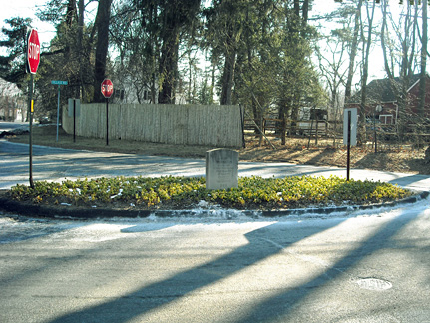
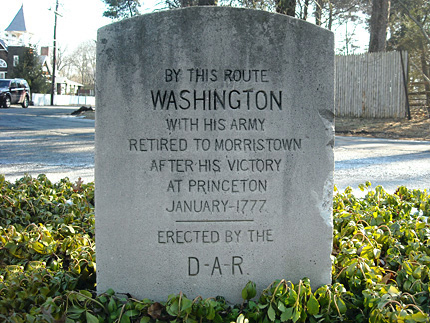

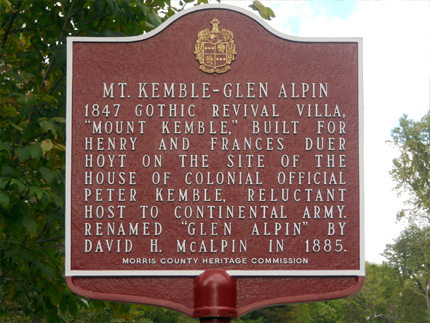
Peter Kemble House Site
Tempe Wick Rd. and Glen Alpin Rd.
Map / Directions to the Peter Kemble House site
Map / Directions to all Harding Township Revolutionary War Sites
Peter Kemble was a Tory during the Revolutionary War, meaning that he was sympathetic to the British. Several of his sons served with the British during the war, and his daughter Margaret was married to the British General, Thomas Gage.
Peter Kemble's home, known as "Mount Kemble," was commandeered by American Generals in two successive winters during the Revolutionary War, while soldiers camped on the surrounding property.
Despite Kemble being a known Tory, he was allowed to remain in his home unharassed. The exact reasons for this are uncertain, but several factors may have contributed to this. One factor was that in 1777 one of his other sons, Richard, took the oath of allegiance to "bear true Faith and Allegiance to the Government established in this State, under the Authority of the People." Another factor may have been Peter Kemble's friendship with Gouverneur Morris, an important American political figure during the Revolutionary War era. It is also possible that Peter Kemble had promised to not publicly proclaim his Tory beliefs. [2]
Encampment of Winter 1779 - 1780
Mount Kemble used as the Headquarters of General William Smallwood
During the winter of 1779, General Washington and the Continental Army returned to Morristown. George Washington made his headquarters at the Ford Mansion, while between ten and twelve thousand camped at Jockey Hollow, which included part of Kemble's property. The winter was brutally cold, with great suffering for the troops.(See the Morristown page for details about the encampment and the conditions.) [3]
While Washington made his headquarters at Ford Mansion, his other high- ranking officers took up residence in other houses in the area. General William Smallwood used Peter Kemble's house as his headquarters. [4]
November 29, 1780 - January 2, 1781
Mount Kemble used as Headquarters of General Anthony Wayne
The Pennsylvania Line Mutiny Occurs [5]
The following winter, a much smaller group of American soldiers encamped at Morristown. General Washington headquartered at New Windsor, New York, while the Continental Army was spread out in small encampments which stretched along the roughly sixty miles from West Point, New York, to Morristown. About 2,500 Pennsylvania troops were encamped at Morristown, under the command of General Anthony Wayne. Wayne used the Kemble house as his headquarters, arriving here on November 29. [6]
Tensions were running high among the troops, who were angry about the lack of sufficient food, clothing, and pay. When they enlisted, the soldiers had been promised that a new set of clothes and a blanket would be issued to them every year. Instead, the realities of supplying the army through the difficult war years had meant that these annual new clothes and blankets had not been issued. As winter weather set in, the lack of these necessities took on a greater urgency.
General Wayne was well aware of the situation among his men. He described the clothes situation in a letter to Pennsylvania Governor Joseph Reed on December 16, " the old worn out coats and tattered linen overalls, and what was once a poor substitute for a blanket, (now divided among three soldiers,) is but very wretched living and shelter against the winter's piercing cold drifting snows, and chilling sleets. Our soldiery are not devoid of reasoning faculties, nor are they callous to the first feelings of nature; they have now served their country with fidelity for near five years, poorly clothed, badly fed, and worse paid; of the last article, trifling as it is, they have not seen a paper dollar in the way of pay for near twelve months." [7]
The situation came to a head when about 1300 of the troops mutinied on New Year's Day 1781, which happened to be the thirty-sixth birthday of General Wayne. Several officers were killed or wounded. The mutineers set out on a march towards Philadelphia, where they intended to demand that Congress take steps to relieve their hardships.
Wayne wrote to Washington the following morning, informing him of the situation: [8]
(Note that the spelling and punctuation in this letter have not been modernized or corrected.)
Mount Kemble 2nd Jany 1781 9. OClock. A.M.
Dear General
The most general and unhappy mutiny suddenly took place in the Pennsa Line about 9. OClock last Night—it yet subists—a great proportion of the troops with some Artillery are Marching towards Phila.
every exertion has been used by the Officers to Divide them in their Determination to revolt—it has succeeded in a temporary manner with near one half—how long it will last God knows.
...
What their temper may be I can not tell—we had our escapes last night—perhaps we may be equally fortunate to day. If not adieu my Dear General & believe me yours Most Affectionately
Anty Wayne Major
General Anthony Wayne and two of his officers followed the mutineers, who never made it to Philadelphia. They reached Princeton on January 3, which coincidentally was the fourth anniversary of the American victory at the Battle of Princeton. Joseph Reed arrived in Princeton the next day, and negotiations were conducted until a settlement was reached on January 8.
On January 20, another mutiny occurred in New Jersey. It began about twenty-five miles northeast of here, and is known as the Pompton Mutiny. See the Bloomingdale page for information about the Pompton Mutiny.
General Anthony Wayne died December 15, 1796. The Township of Wayne was named for him in 1847.
The Peter Kemble House after the Revolutionary War [9]
The Peter Kemble House was moved about a quarter mile north on Glen Alpin Road in 1846. It is now a private home. It sits on the hillside above Glen Alpin Road. The house is not visible from the road because it is hidden by trees.
A new house was built here in 1847, and the property was renamed "Glen Alpin" in 1885. For more information about Glen Alpin and the current house, see the Glen Alpin Conservancy website.
Peter and other members of the Kemble family are buried on the property.

1. ^ These markers erected by the Daughters of the American Revolution
• For more details and accompanying source notes about the Battle of Princeton and the 1777 Morristown encampment, see the Princeton and Morristown pages of this website.
2. ^ The Kemble Period / History section of the Glen Alpin Conservancy website provided most of the information for these three paragraphs
• John T. Cunningham, The Uncertain Revolution - Washington & the Continental Army at Morristown (West Creek NJ: Cormorant Publishing, 2007) page 81-82
▸ Cunningham states that Kemble was permitted "to remain in his house by promising not to be aggressive in proclaiming his beliefs." He does not mention Richard's taking of the Oath of Allegiance or Peter's Friendship with Gouverneur Morris, both of which are listed as factors on the Glen Alpin Conservancy website.• For more information about the Oath of Allegiance (or Loyalty Oath), including the full text, see:
Larry R. Gerlach, Editor, New Jersey in the American Revolution, 1763-1783: A Documentary History (Trenton: New Jersey Historical Commission, 1975) pages 363-364
These pages are available to be read as a PDF at the New Jersey State Library website here
• For architectural details about Mount Kemble, the original Peter Kemble house, see:
National Register of Historic Places / Inventory - Nomination Form for Mount Kemble
Available as a PDF on the National Park Service website here
3. ^ For more information and accompanying source notes about the winter 1779-1780 Morristown encampment, see the Morristown page of this website.
4. ^ John T. Cunningham, The Uncertain Revolution - Washington & the Continental Army at Morristown (West Creek NJ: Cormorant Publishing, 2007) page 96
The Kemble Period / History section of the Glen Alpin Conservancy website
5. ^ In addition to contemporary sources listed in source notes 6 - 8, the following works were consulted for this section
John T. Cunningham, The Uncertain Revolution - Washington & the Continental Army at Morristown (West Creek NJ: Cormorant Publishing, 2007) page 96
Ron Chernow, Washington: A Life (New York: The Penguin Group, 2010)
6. ^ Washington wrote to Wayne on November 27, 1780, stating, "You will march with the Division under your command to the Ground in the Neighbourhood of Morris Town." The complete letter can be read at the National Archives website:
“From George Washington to Brigadier General Anthony Wayne, 27 November 1780,” Founders Online, National Archives, https://founders.archives.gov/documents/Washington/03-29-02-0242. [Original source: The Papers of George Washington, Revolutionary War Series, vol. 29, 28 October–31 December 1780, ed. William M. Ferraro. Charlottesville: University of Virginia Press, 2021, pp. 370–373.]
Three of Wayne's letters to Washington, dated December 10, 1780; December 25, 1780; and January 2, 1781, are marked as being sent from "Mount Kemble." The three letters can be read at the National Archives website:
“To George Washington from Brigadier General Anthony Wayne, 10 December 1780,” Founders Online, National Archives, https://founders.archives.gov/documents/Washington/03-29-02-0315. [Original source: The Papers of George Washington, Revolutionary War Series, vol. 29, 28 October–31 December 1780, ed. William M. Ferraro. Charlottesville: University of Virginia Press, 2021, pp. 480–482.]
“To George Washington from Brigadier General Anthony Wayne, 25 December 1780,” Founders Online, National Archives, https://founders.archives.gov/documents/Washington/03-29-02-0418. [Original source: The Papers of George Washington, Revolutionary War Series, vol. 29, 28 October–31 December 1780, ed. William M. Ferraro. Charlottesville: University of Virginia Press, 2021, pp. 611–613.]
“Brigadier General Anthony Wayne to George Washington, 2 January 1781,” Founders Online, National Archives, https://founders.archives.gov/documents/Washington/03-30-02-0023. [Original source: The Papers of George Washington, Revolutionary War Series, vol. 30, 1 January–6 March 1781, ed. Benjamin L. Huggins. Charlottesville: University of Virginia Press, 2022, pp. 29–32.]
7. ^ Anthony Wayne letter to Joseph Reed, December 16, 1780, reprinted in:
William B. Reed, Life and Correspondence of Joseph Reed: Military Secretary of Washington, at Cambridge, Adjutant-general of the Continental Army, Member of the Congress of the United States, and President of the Executive Council of the State of Pennsylvania, Volume 2 (Philadelphia: Lindsay and Blakiston, 1847) pages 315 - 317
Available to be read at Google Books here
▸ Reed's official title was President of the Supreme Executive Council of Pennsylvania, which is the equivalent of governor.
▸ Note that Wayne's letter is marked as being sent from Mount Kemble.8. ^ “Brigadier General Anthony Wayne to George Washington, 2 January 1781,” Founders Online, National Archives, https://founders.archives.gov/documents/Washington/03-30-02-0023. [Original source: The Papers of George Washington, Revolutionary War Series, vol. 30, 1 January–6 March 1781, ed. Benjamin L. Huggins. Charlottesville: University of Virginia Press, 2022, pp. 29–32.]
9. ^ The Kemble Period / History section of the Glen Alpin Conservancy website